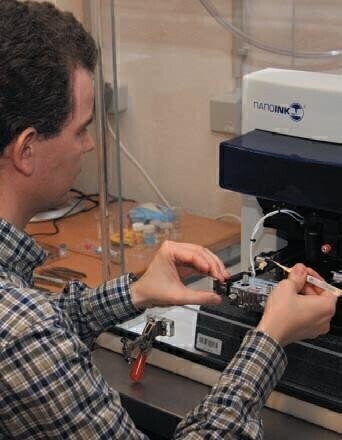Laboratory Products
Nanolithography System Chosen to Study Assembly of Nanoparticles
Feb 15 2010
The Institute of Inorganic Chemistry (IAC) at the RWTH University of Aachen has recently taken delivery of NanoInk’s flagship Dip Pen Nanolithography® (DPN®) research platform, the DPN 5000. This will be used to fabricate conducting nanostructures independently of any structure- guiding templates, and for this purpose it is much more flexible than any other lithography techniques, such as e-beam or EUV lithography.
As part of the Institute of Inorganic Chemistry, the group of Professor Ulrich Simon, chair of Inorganic Chemistry and Electrochemistry, focuses on the synthesis, characterisation and assembly of metal and semiconductor
nanoparticles, nanostructures and biomolecular materials. Assembly at the nanometer scale on isolating and semiconducting surfaces will be facilitated by DPN. Research will investigate the interplay of microstructure and their electrical properties. In turn, this will complement the existing in-situ measuring system.
The main applications will include the oriented deposition of gold nanoparticles; the writing of conducting metal structures of arbitrary shape; and the nanostructuring of metal oxides. Eventually, applications could include taking the microelectronic chip down to the nano scale. There is also interest to study the electronic properties of biofunctionalised nanoparticles.
The DPN 5000 is the latest member of the NSCRIPTOR® family of instrumentation. It combines versatile nanopatterning capabilities with high-performance AFM (atomic force microscopy) imaging. Together with a complete suite of micro-electro-mechanical systems (MEMs) based ink delivery devices, users are able to commence creating their own nanostructures hours after installation.
It features a new, ultra-low noise scanner with closed loop flexure technology allowing for accurate and repeatable nanoscale patterning in x, y and z. The low coherence laser with small spot size ensures high quality lateral force (LFM) imaging for the improved detection of chemically patterned substrates. Operating on an industry standard Linux® controller and with input from over one hundred users worldwide, NanoInk has developed new InkCAD™ 4.0 software for improved control of tip-based patterning.
Digital Edition
Lab Asia 31.2 April 2024
April 2024
In This Edition Chromatography Articles - Approaches to troubleshooting an SPE method for the analysis of oligonucleotides (pt i) - High-precision liquid flow processes demand full fluidic c...
View all digital editions
Events
May 21 2024 Lagos, Nigeria
May 22 2024 Basel, Switzerland
Scientific Laboratory Show & Conference 2024
May 22 2024 Nottingham, UK
May 23 2024 Beijing, China
May 28 2024 Tel Aviv, Israel









.jpg)








